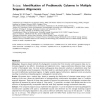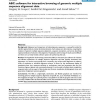5 search results - page 1 / 1 » Noisy: Identification of problematic columns in multiple seq... |
ALMOB
2008
13 years 4 months ago
2008
Motivation: Sequence-based methods for phylogenetic reconstruction from (nucleic acid) sequence data are notoriously plagued by two effects: homoplasies and alignment errors. Larg...
BMCBI
2004
13 years 4 months ago
2004
Background: Alignment and comparison of related genome sequences is a powerful method to identify regions likely to contain functional elements. Such analyses are data intensive, ...
BMCBI
2008
13 years 4 months ago
2008
Background: A multiple sequence alignment (MSA) generated for a protein can be used to characterise residues by means of a statistical analysis of single columns. In addition to t...
NAR
2010
12 years 11 months ago
2010
Evaluating the accuracy of multiple sequence alignment (MSA) is critical for virtually every comparative sequence analysis that uses an MSA as input. Here we present the GUIDANCE ...
BMCBI
2006
13 years 4 months ago
2006
Background: Several entropy-based methods have been developed for scoring sequence conservation in protein multiple sequence alignments. High scoring amino acid positions may corr...


